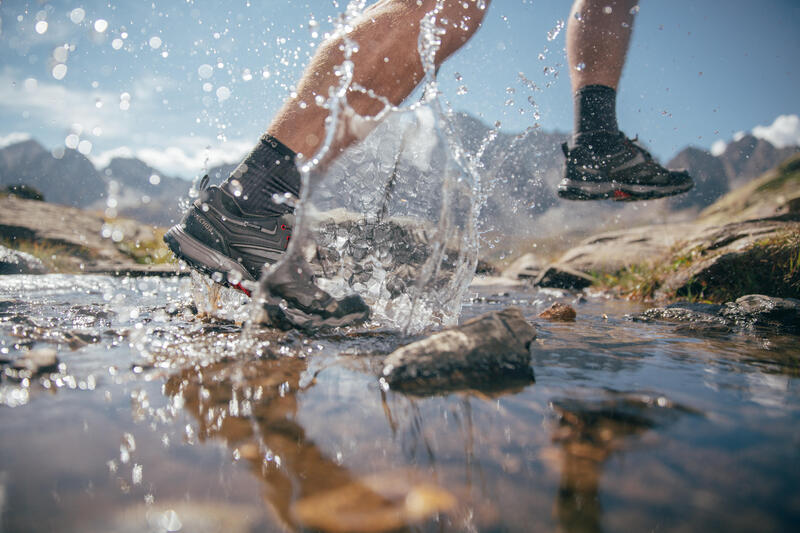HOW OFTEN AND HOW INTENSIVELY SHOULD YOU HIKE?
We have classified our products in terms of performance and functionality to suit 3 levels of mountaineering experience:
- Occasional: around ten hikes a year, lasting 3 to 4 hours, less than 10km and less than 700m ascent.
- Regular: around twenty outings a year. 4 to 6 hours, 10 to 20km, 700 to 1200m ascent per outing.
- Intensive: more than 20 outings per year. More than 6 hours, more than 20 km, 1200 to 2000m ascent per outing.
Sole with grip
The grip of our soles is certified. To qualify, the shoe must pass laboratory tests to evaluate the grip coefficient on different surfaces (smooth, rough, dry, wet). To validate these tests, we have the quality of our soles evaluated in the field, in the mountains, by a panel of representative testers over 500 km.
Waterproof test
In the laboratory, the shoe is placed in water up to mid-shaft on a mechanical arm generating flexions of the shoe to simulate a number of steps. Thanks to this test, we can determine a time and a number of km that the shoe can cover while remaining dry. Then we validate on the ground and in the rain that the shoe keeps its promises in use.
Extending waterproofing
To keep your feet dry, we recommend using a waterproof gaiter or mini-gaiter to protect the upper part of the shoe from water ingress, as well as from stones and sand...
We recommend waterproofing your shoes twice a year with a waterproofing product (search for "waterproofing" on our decathlon website), which will restore their original water repellency and combat external stains.
Which size to choose?
The most important thing is to try on several sizes and models of shoes to find the one that's right for you!
You can go one size bigger than your usual shoe size to avoid your toes banging against the ground on the way down, as long as your foot is well supported to avoid rubbing.
Tip: keep your nails short and check before any long descent that your lacing is tight enough to prevent your foot from sliding towards the front of the shoe.
Buying advice / How to try on your shoes?
Some Decathlon stores are equipped with a test trail.
1. Try on both shoes, standing up, with the socks you use for hiking.
2. Tighten the laces, taking care to distribute the tightening evenly.
3. Check two points:
- the heel does not lift off the front of the shoe when walking uphill.
- the foot does not slip and the toes do not touch the front when walking downhill.
4. Try on several sizes and models.
Use them progressively to make them fit your foot.
HOW TO AVOID BLISTERS?
Find all our tips here:
https://conseilsport.decathlon.fr/conseils/9-astuces-pour-eviter-les-ampoules-tp_10725
Which socks?
Waterproof footwear is less breathable than non-waterproof footwear. Socks like the MH500 in medium upper are therefore preferable for wicking away perspiration and limiting chafing.
Optimize the performance of your shoes: replace your insoles!
The original insole in your shoes is designed to fit as many feet as possible. A change of insole can provide:
1. Better support: some insoles are preformed or reinforced to better support the arch of the foot.
2. Greater comfort: insoles can also provide warmth and/or cushioning.
3. Longer life: get back the support and comfort of your shoes by replacing the insole every season.
How to care for your shoes
- Allow to air dry.
- Remove dried mud with a fairly hard brush.
- For stains, clean with a brush and a little lukewarm water.
- Allow to dry.
- Spray with a waterproofing spray to restore water repellency to the stem.





